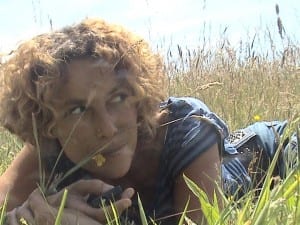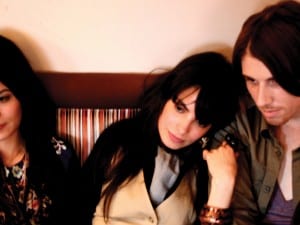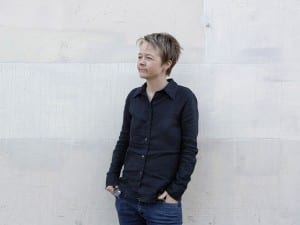Attila Olah is a Liverpool Hope University graduate whose practice revolves around symbolism, manipulating forms and pushing the boundaries of transient materials. Working as a commercial ice sculptor at Glacial Art Ice Sculptors and working under the wings of Claudi Casanovas, Catalan ceramic sculptor, Olah bridges the gap between ceramics and ice, juxtaposing and merging the media to create something wholly new.
A: Your practice holds sculpture at its core – often focusing on the vessel as a symbol of human life. What thematic concepts do you explore in your work?
AO: The vessel is a profoundly sacred and secular symbol at once that pervades some of the most fundamental aspects of human life. The vessel both as a concept and as an artefact is intimately entwined with our ideas and rituals surrounding the phenomena of birth, growth, worship and death, which to a large extent define us as a species. Exploring these themes one inevitably has occasion to arrive at the predicament of mankind whose relatively recent history is the story of an ego-dominated society that has lost contact with the divine. The individual is left in pursuit of truth or beauty, desperately trying to capture the essence of that which is somehow felt but cannot be materialised. Using the vessel as a vehicle for self-enquiry is my attempt to transcend a fragment of “that” nto this world, to restore for myself and for others that which has been forgotten.
A: Do you think it’s true that artists are increasingly returning to traditional forms of craftsmanship, including using raw materials?
AO: Art and craftsmanship are two words that tend to be somewhat problematic to reconcile without an acknowledgement of the art and craft debate. Certain practices and their practitioners have long been burdened with a complex cultural baggage around skilled labour, resulting in the denial of their status as art and artist. Thus craftsmanship as well as the mediums and disciplines associated with it, have until recently remained on the peripheries of the art scene. Over the last two decades however, the crafts have been enjoying a Renaissance, many of its practitioners, such as Greyson Perry and Edmund de Waal gaining high status within the art world. I, personally do not observe an upsurge of artists returning to craftsmanship or to the use of raw materials. Rather, what seems to be happening is a gradual or temporary embracing of craftspeople within the hierarchy of the art world.
A: What is the relevance of this hands-on approach to you?
AO: I think that the idea of a hands-on approach implies that one’s work is somehow backward-looking and nostalgic or that it wears gestural marks of the maker’s hands. I would like to emphasize that my practice is not concerned with these connotations. Throwing on the potter’s wheel, one cannot help but feel connected to the past. The very material with which the maker engages is saturated with the memories of geological processes that may have had a crucial part to play in the genesis of human life.
Informed by an intimate engagement with raw materials and processes, my practice increasingly gravitates toward simplicity, both in its execution and aesthetic qualities. As a maker, I apply myself fully, my hands alone would not suffice. I let the past, present and future filter through me and deposit their residue in the mould of my imagination. I have trust in my inability so I wait for a space to open up in me. I “download” the information from what feels like another plane, as truthfully as I possibly can. And times innumerable I fail. So the process is repeated until the distance between my imagination and the work in front of me becomes bearable.
A: How important do you think it is for artists to re-consider traditional methods with their own interpretation? How do you think this creates new layers of meaning?
AO: The time, skills and resources required to pursue traditional methods of art as a profession have put enormous pressure on the artist. For this reason, some methods have simply become obsolete, some are exploited as curiosities, while others somehow manage to persist. The latter category is where re-interpretation seems to happen most successfully and of which the studio pottery tradition happens to be a perfect example.
Pottery has undergone a steep development since the 1920s both from inside and outside of the discipline. Bernard Leach and William Staite Murray, British artist-potters almost singlehandedly managed to elevate pottery into the limelight of the contemporary art scene, at the height of their careers, exhibiting alongside artists such as Henry Moore, Barbara Hepworth, Jacob Epstein and Paul Nash. Embracing notions of the Arts and Crafts Movement, Abstract Art and Eastern Philosophy and Aesthetics within their practice, Leach and Murray revitalised pottery making in this country and beyond. Laying down the foundation stones of what later was to become the Studio Pottery Movement, Murray and Leach fertilised new grounds for generations to come.
Whether artists like to admit or not, one is deeply reliant on tradition. One must stand on the shoulders of what has been done before in order to reach further than one would otherwise be capable. Feeding from and feeding back into the well of humanity is what generates a continuum. Layers and layers of meaning, no matter how transparent or insubstantial they may appear, allow us to make progress.
A: Your practice includes sculpting with ice as well as ceramics. One seemingly is quite transient, whilst the other more permanent. What resonance do you think this creates in terms of visual languages and new contexts?
AO: Through making transient artworks, one has the ability to create a sense of wonder as well as to trigger a sense of impending doom. Inbuilt within is a self-destruct mechanism that defies one’s expectations of the display, sale, and preservation of the artwork. Ephemeral artworks are curatorial curiosities that galleries and museums may or may not be willing or capable of accommodating. Having a short “life-span”, such pieces are unstable and difficult to categorise, often requiring one to find or create an environment in which the work can be viewed.
A: What do you have planned in terms of future projects?
AO: I am currently undertaking a residency through the AA2A scheme at Liverpool Hope University in order to develop a new body of work towards a potential solo exhibition in June 2018. Recently, I have also become involved in collaborative project that amalgamates photography, painting, sculpture and furniture design, alongside Liverpool-based artists, Angelo Madonna and Simon Job.
For more information about the artist, click here.
For more information about Liverpool Hope, click here.
Credits:
1. Attila Olah, Holdszarv On the Cusp, 2017. Courtesy of the artist.





